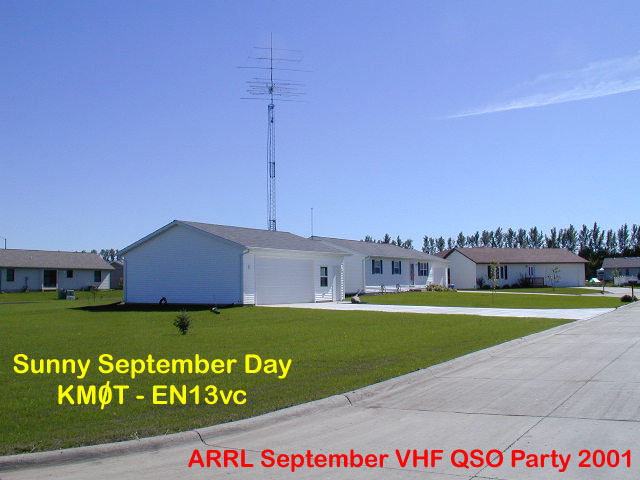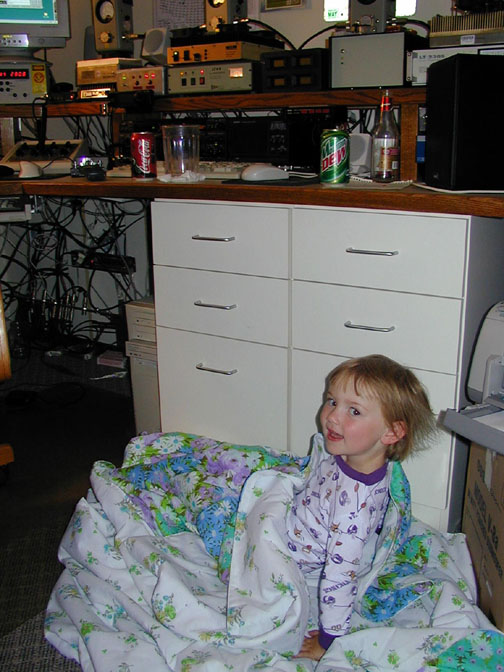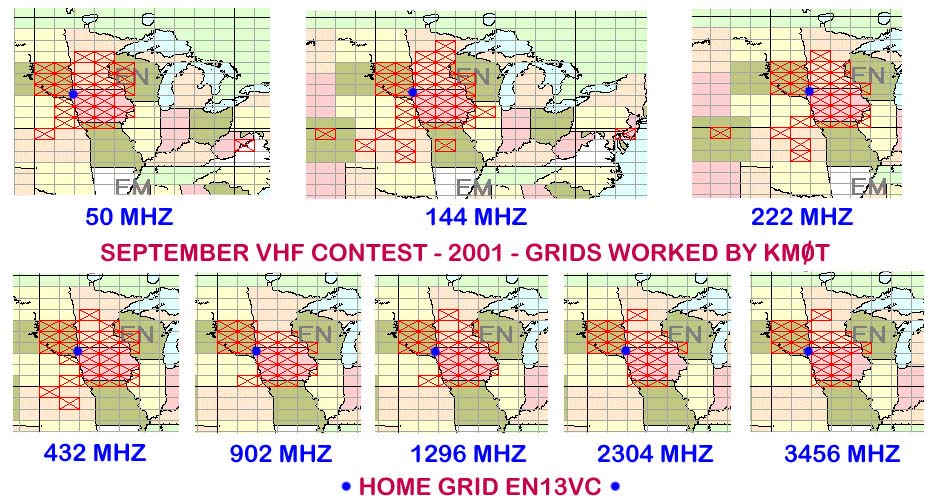
Tropo Takes a Hike….
The tropo wound not hold, which was the consensus as we chatted on the air a few days before the contest. Gene, NØDQS and I had lots of luck the prior weeks before the September Contest, all with hope that it would still be there. Unfortunately, the rain came through for a few days and the high pressure we had with some good temps left the area. The Hepburn tropo map lookout for the weekend looked grim as well, almost like it looks in mid February on the tropo map.
Everything is not what it seems….
Again, there was no time for projects or station improvements before the contest, things seemed to operating well a few weeks before the contest. No foreseen issues were at hand until the weekend before, when I had a major blowup in my 2304 / 3456 Mhz tower box. Boy did I have to scramble!
That week before, I had just finished putting a small log period antenna together with a SMA connector to connect to my DEMI weak signal source. I got that all together and fired up the transverters on the tower. I was playing around with it to see how the directivity of the log periodic was from the weak signal source, listening back and forth on 2304 and 3456 Mhz. This went on for a few minutes and then I noticed, for no reason, the FT-100D IF screen went dead and I lost all the audio in the receiver. Hmmmmmm I thought, very strange. I quickly disconnect the DC line to the transverters box on the tower and all of a sudden, the display on the FT-100D came back on.
I thought for a minute (probably should have thought a few more however) and figured it was an anomaly. I proceeded to connect the positive line of the DC lines to the transverter box back to the power supply and "POW" a big spark jumped out where I was connecting it. I noticed the FT-100D went dead momentarily and came back to life. Direct short to ground I thought, how could that be?
I turned all the power supplies off in the shack and got out the VOM. I tested across the DC lines to the transverter box on the tower, sure enough, a dead short. I let out a groan…not this now, the contest was a week away! How did I manage to break it!
The Investigation Begins…..
Everything else seemed to be working fine so I decided to sleep on it and check the DC lines again in the morning. The short was definitely there. Plans were then made to get the tower laid down on its side but rain and wind was in the forecast. I also took a binoculars and looked up the tower to see if the DC power cable running up the tower seemed to be shorted to the tower itself, but could not determine anything that way.
A break in the WX happened and I got the tower laid down. I disconnected the power and signal control cables at the transverter box. (See the 2304 / 3456 construction project for the box design) I then went to the shack and tested for a short in the DC lines again. No continuity was noted. The short was not in the DC line. That then led me to test the power connector + and – terminals on the actual transverter/amp box. Sure enough, the short was somewhere in the box. Another groan…..
I removed the RF superflex to the loopers and the IF cable. I then unbolted the entire assembly and brought it into the shack. A little more testing and I determined that the DC short was in the 3456 Mhz transverter.
I began to look at the schematic for the DC input to the transverter and compared it to both the 2304 and 3456 Mhz transverters. There appeared to be a direct short through some type of voltage suppressor connected from the + side of the DC input and the actual case. I removed the component and the DC short was then gone and bench tested the transverter. Everything appeared to be working and I felt very lucky nothing else was fried.
The Fix!
The schematic showed some type of diode, a zener perhaps but it was a symbol that I was not familiar with. A trip to an electronics store in Sioux City revealed that it was a "Bi-directional over-voltage transient suppressor" with a rating of 13.6 volts. Well, the voltage I run down at the shack is 14.2 and with the large size of the DC cable I run up to the tower box, it appears that I exceeded the rating on the component. Since they had been running just fine in the past and the 2304 transverter was still worked fine, I concluded that the tolerance in the component in the 3456 Mhz transverter was probably a bit lower, thus it failed.
I could only find a 15.3 volt rated unit as a replacement on quick notice, so I put that one in as a replacement.
I then took some friendly advice and put 3-amp fuses in line with the DC inputs of each transverter for protection. Had I put them in there before, It would have at least allowed operation of the 2304 transverter. Again, I considered myself very lucky knowing that I was sending quite a few amps though the metal case of the transverter as it was shorted to the DC line. Quickly turning the power off probably saved the whole transverter. The two Astron 70 amp supplies I use in parallel had no trouble delivering the current and never tripped out either!
I got the box back on the tower and all the cables hooked up. Got my weak signal source going and tested everything out. Everything seemed to be working and I got the tower back up the Thursday night before the contest began.
MORAL OF THE STORY - FUSE YOUR TRANSVERTERS!!!
The Contest – ARRL September VHF 2001
Everything was working right before the contest. Gene, NØDQS/R was going to start out to the South by the Missouri and Iowa border, EN20 area. We were going to work MO for states on a few bands before the contest began. Well, Gene got a late start and the bands were cruddy as the contest began. Gene changed locations a number of times before we were able to work on 3456 Mhz. The rest of the bands were fair to bad, but 3456 took some time to get tropo peaks.
There was not any propagation to speak of for most of the contest. I kept looking for 6 Meter Eskip, but nothing was ever heard. Tropo conditions where such that most contacts were regional for the most part.
Therefore, most of the time was spent chasing rovers and calling CQ a lot, trying to pick up stragglers.
Worked NJ - K2TXB - Russ on meteor scatter HSCW, also K8GP early morning on SSB meteor scatter. Other than that, nothing else to the east.
About the only really exciting thing was hearing some very weak CW on 144 Mhz and finally figuring out it was DM79, Colorado. I managed to pick up the grid on 2M and 222 Mhz. Kind of a nice little catch. The tropo was short lived and very weak.
NØDQS/R and I continued throughout the contest and worked in every grid on all bands. However, 3456 Mhz continued to be a struggle on the outer grids. I kept telling him that he was much weaker on that band then he was during the UHF and June Contest. We really did not think much of it and worked on CW most of the time.
Not a whole else to report out of the ordinary, it was truly a test of the tropo forward scatter mode. How well could you hear and if you could get lucky to have the beam on someone who was 400 miles out and happened to be calling CQ at the time.
I did manage to have my good luck charm Patricia hanging out in the shack during the contest. She likes to bed down and see what dad is up to during the contests!

Patricia is sure growing up fast, she turned 3 years old this September. Pretty soon she may be grabbin the mic out of my hands!
Contest Summary: KMØT
|
Band |
QSOs |
Pts |
QSO Pts |
Grids |
|
50 MHZ |
54 |
1 |
54 |
28 |
|
144 MHZ |
100 |
1 |
100 |
37 |
|
222 MHZ |
53 |
2 |
106 |
27 |
|
432 MHZ |
53 |
2 |
106 |
26 |
|
902 MHZ |
22 |
3 |
66 |
19 |
|
1296 MHZ |
32 |
3 |
96 |
21 |
|
2304 MHZ |
19 |
4 |
76 |
18 |
|
3456 MHZ |
18 |
4 |
72 |
18 |
|
Totals All Bands |
351 |
676 |
194 |
KMØT CLAIMED SCORE: 131,144
This was my best effort yet for the September Contest, but with lousy propagation. (September 2000 Score was: 81,324)
"The Rover’s Corner" ©
What can I say, as always, the rovers helped out. Here is the chart of Rover activity I worked:
|
BAND |
NØDQS/R |
KØPG/R |
K9ILT/R |
NØLNO/R |
KBØTHN/R |
WØAMT/R |
KCØAKJ/R |
NAØIA/R |
|
50 MHZ |
15 |
1 |
1 |
2 |
0 |
0 |
0 |
1 |
|
144 MHZ |
15 |
8 |
8 |
3 |
2 |
1 |
1 |
1 |
|
222 MHZ |
15 |
7 |
7 |
2 |
0 |
0 |
0 |
0 |
|
432 MHZ |
15 |
5 |
5 |
1 |
1 |
0 |
0 |
0 |
|
902 MHZ |
15 |
0 |
0 |
1 |
0 |
0 |
0 |
0 |
|
1296 MHZ |
15 |
1 |
1 |
1 |
0 |
0 |
0 |
0 |
|
2304 MHZ |
15 |
0 |
0 |
0 |
0 |
0 |
0 |
0 |
|
3456 MHZ |
15 |
0 |
0 |
0 |
0 |
0 |
0 |
0 |
|
Total QSOs |
120 |
22 |
22 |
10 |
3 |
1 |
1 |
2 |
Total Rover QSOs = 181
Rover QSOs % of Total QSOs = 51.5% WOW! Who says rovers are not necessary? Another clean sweep with NØDQS/R.
Looking back to last year, September 2000: 137 QSOs were with rovers and that came in at 48% of total Qs. It seems to be a trend for September, not as many fixed stations on or the propagation just never measures up to a June Contest scenario.
A special thanks to all the rovers, especially the top 3 - NØDQS/R, KØPG/R and K9ILT/R. Without contacts from them, the score would be much lower. I know they contributed to many fixed station scores.
GRID CHARTS
Here are some grid charts showing the extent worked on the various bands. These where clipped from Vqlog. I was able to export in ADI format for my contest data from VHFDX (which I feel is superior in speed and ease of use for logging these VHF contests) The data transferred very quickly to Vqlog without any problems. The neat thing about Vqlog is that it has the ability to generate graphs, maps and charts based on the QSO data.

As one can see, the propagation was very regional for all bands. I managed just a few grids outside of the region. To Colorado: just a brief burst of tropo late Sunday afternoon. The lone 2M and 6M grids out east were meteor scatter propagation. No Es or Aurora was observed. I heard that the east got some good tropo propagation up and down the coast, their scores I would imagine will tromp anything from the Midwest. ( I just read the scores on the ARRL members website, I got killed by the East Coasters…oh well J )
CLOSING
Oh, one last thing, after the contest, Gene (NØDQS/R) and I checked the rover gear out. It appeared that the IF rig that was driving the transverters for 902, 2304 and 3456 had dropped its output to around 1/2 a watt at 144 Mhz. We still had fairly good power on 902 and 2304 Mhz, but the 3456 Mhz transverter and Amp was measured at about 300 milliwatts. Couple that with the loss of the cable to the antenna, probably around 150 to 200 milliwatts to the antenna. Just goes to show you what a 112 Element looper on 3456 Mhz can do -18 Grids with no tropo! Call Dave at Directive Systems and tell em I sent ya!
73 and See you all again.
Mike - KMØT en13vc